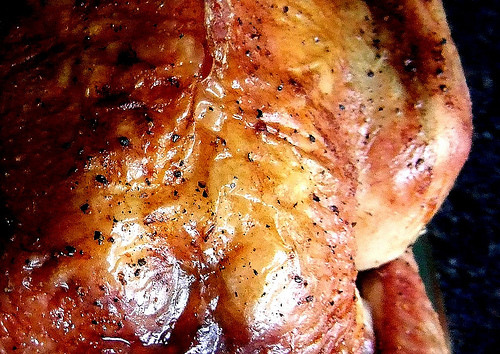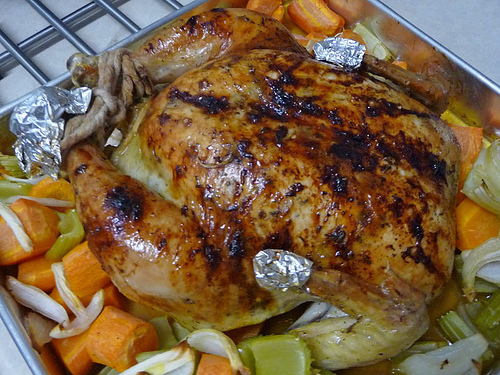Roasting a whole chicken

Speaking of the magical, $3-off, close-to-the-sell-by-date whole raw chickens that I have been buying from Target, let's talk about what to do with a whole chicken. I think the best use of a whole chicken (certainly the easiest) is to roast it.
Why DIY?
You might be thinking, "Why should I go to all the trouble? I can buy a rotisserie chicken at the store for the same amount of money, and it's already cooked and hot and delicious and ready to eat." Well, two reasons.
The first is, they put a lot of wacky stuff in those rotisserie chickens. Check the ingredients list sometime, you might be surprised. Pre-cooked rotisserie chickens have a ton of sodium, they have been sweetened (typically with corn syrup), and they have a lot of preservatives and chemicals that you won't find in your average broiler chicken.
The second reason is that it's not much of a bargain. The typical grocery store heat lamp rotisserie chicken is about 2.5lbs. A significant portion of that weight is juice (i.e. the saline solution they inject it with). For about the same cost you can buy a raw whole chicken that is around 6lbs. That's over twice as much meat for the same price!

Image courtesy Flickr/Rosie 55
Roasting Methods
I recently experimented with roasting a chicken in the slow cooker. I was surprised at how well it worked. The meat turned out fully cooked and tender, but not soggy (as I feared). The skin was even reasonably crispy, although it was a little on the leathery side.
But by far, the best way to roast a chicken is in the oven. You need an oven large enough to fit the chicken inside, while still leaving about an inch of clearance at the top, and at least six inches from the element at the bottom. For most people that won't be a problem. If you have a half-size stove, read on: I have some tips for you.
Prep Work
You can get pretty fancy with the roasting work. For example, you can stuff the cavity with a blend of chopped vegetables (celery, onion, garlic, and carrots). You can slip bay leaves and garlic slivers under the skin. You can rub it all over with olive oil or butter. Etc.
But if you just want to roast a chicken with the minimum of fuss, here is what you need to do:
1. Take it out of the package, reach inside the cavity, and remove the giblets. Sometimes they are inside a little paper pack. Other times they are just crammed in there. Some chickens have no giblets.
I guess you are supposed to make gravy with the giblets or something? I think they are gross and I throw them away. I would pay extra for a chicken without giblets inside. You can have mine if you want. Yuck.
2. Rinse it in cold water. This does little to remove bacteria and other pathogens, but I find that whole chickens sometimes have a bit of sludge on them, and I like my food tidy.
3. Pat it dry with paper towels. A good crisp skin comes from a dry bird.
4. Sprinkle it with salt and pepper. This is the step where you can add other stuff if you want. I like to use "Chicken Seasoning," which is a spice mix that is heavy on the thyme.
5. Set it in a 9x13 pan, and cook it for 20 minutes per pound (plus an extra 15 minutes) at 350 degrees. When it is finished cooking, take it out and let it sit for 10 minutes before you start carving. Resist the urge to pull off one of the wings and nibble on it. Resist, I say!

Image courtesy Flickr/suanie
If You Have A Small Oven
I live in a small home with a half-size oven. Here are the adjustments I have made:
1. Loosely tent the bird with foil before putting it in the oven. You don't want to trap any steam; you just want to prevent oil from splattering against the top of the oven.
2. Don't use the lowest rack setting. Use the second- or third-lowest. Get the bird as high up as you can, while still letting it fit into the oven.
3. Reduce the heat to 325 degrees and cook for an extra 5 minutes per pound (25 minutes per pound plus an extra 15). The lower temperature helps keep the oil in the pan from splattering too badly.
Image courtesy Flickr/vauvau

0 comments